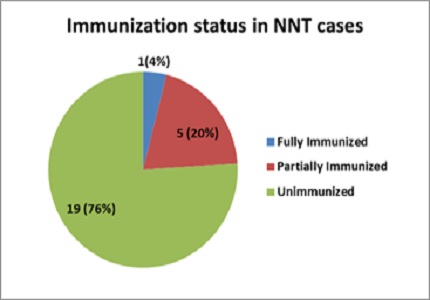A study of clinical profile of childhood tetanus in south Gujarat area
Abstract
Introduction: Despite the availability of cheap, safe and effective vaccine, tetanus is still a serious health problem worldwide and rural India, and a common cause of death in the new born. Community surveys have shown that only a small proportion of neonatal tetanus (NT) cases are routinely reported and under – reporting is often highest in areas at highest risk of NT. So, the objective of the study was to find out the epidemiological factors, clinical profile and outcome of childhood tetanus. Also to find out the preventable factors and prognostic factors in childhood tetanus.
Methods: It was a prospective observational study. Legal guardians of all children less than 12 years old including neonates with diagnosis of tetanus admitted in pediatric department were inquired for detailed history regarding the present complaint, history of sources of infection, history of antenatal care, immunization status and detailed labor history. Grading of tetanus was done after detailed general and systemic examination.
Result: Total 35 cases were included in the study with Male: Female ratio of 1.7:1. Among them 28.57% were neonatal tetanus and 28.57% were traumatic case. Among 10 neonatal tetanus cases 9 mothers were not immunized and among 25 non-neonatal cases 19 were unimmunized. Mortality was 90% in NT cases and 36% in Non-Neonatal Tetanus (NNT) cases. Common complication were septicemia [9 (25.71%)], Disseminated Intravascular Coagulation (DIC) [8 (22.85%)], Hyperpyrexia [7 (17.14%)], Pneumonia [5 (14.28%)], Bed sore [3 (8.5%)], and thrombo phlebitis [1(2.8%)] of cases.
Conclusion: Although incidence of childhood tetanus has been reduced over the years, but still tetanus is more common in rural population due to illiteracy, poor socioeconomic status, poor vaccination and superstitions. The mortality by tetanus can be reduced by improving routine immunization specifically in rural and low socioeconomic population, by recognition of disease severity and providing proper management with intensive care as early as possible.
Downloads
References
2. CDC. Diphtheria, tetanus, pertussis: recommendations for vaccine use and other preventive measures. Recommendation of Advisory Committee (ACIP). MMWR 1991; 40 (No. RR-10): 1 -28.
3. K Park. Textbook of Preventive and Social Medicine, 22nd edition; Jabalpur:M/S BanarsidasBhanot Publisher; 2011:283 – 287.
4. Tullu MS, Deshmukh CT, Kamat JR. Experience of pediatric tetanus cases from Mumbai. Indian Pediatr. 2000 Jul;37(7):765-71. [PubMed]
5. Poudel P, Singh R, Raja S, Budhathoki S. Pediatric and neonatal tetanus: a hospital based study at eastern Nepal. Nepal Med Coll J. 2008 Sep;10(3):170-5.
6. Chetry S. Clinical study of pediatric tetanus: a hospital based study. 2005. www.pediatriconcall.com.
7. Bhat GJ, Joshi MK, Kandoth PW. Neonatal tetanus--a clinical study of 100 cases. Indian Pediatr. 1979 Feb; 16 (2):159-66. [PubMed]
8. Mondal T, Aneja S, Tyagi A, Kumar P, Sharma D. A study of childhood tetanus in post-neonatal age group in Delhi. Indian pediatrics. 1994 Nov 1;31:1369.
9. Hatkar N, Shah N, Imran S, Jadhao A. Study of incidence, mortality & causes of neonatal tetanus among all Neonatal Intensive Care Unit [NICU] admissions in tertiary health care center of SBHGMC, Dhule. Journal of Evolution of Medical and Dental Sciences. 2015 May 18;4(40):6967-73.
10. Aggarwal M, Sood V, Aggarwal KC. Tetanus in Pediatric Patients-Predictors Affecting Mortality and Role of Immunoglobulin. Indian pediatrics 2011;48: 987-988.
11. Patel JC, Mehta BC. Tetanus: study of 8,697 cases. Indian journal of medical sciences. 1999 Sep; 53 (9): 393-401. [PubMed]
12. Phatak AT, Shah SB. Indices of severity of neonatal tetanus. Indian Pediatr. 1973 Feb;10(2):87-91. [PubMed]
13. Geeta MG, Krishnakumar P, Mathews L. Intrathecal tetanus immunoglobulins in the management of tetanus. The Indian Journal of Pediatrics. 2007 Jan 1; 74 (1): 43-5. [PubMed]

Copyright (c) 2018 Author (s). Published by Siddharth Health Research and Social Welfare Society

This work is licensed under a Creative Commons Attribution 4.0 International License.


 OAI - Open Archives Initiative
OAI - Open Archives Initiative


